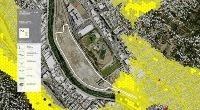Drylands Resilience Initiative [DRI]: Digital Tools for Sustainable Urban Design in Arid and Semi-arid Urban Centers

Led by the Arid Lands Institute (ALI), the Drylands Resilience Initiative [DRI] brings together collaborators from design, science, and policy to envision and realize an abundant future in drylands. Our goal is to accelerate planning, design, and development that results in local, low-carbon water reserves in dry cities in the US West and around the world. DRI collaborators honed and tested Hazel, a powerful new digital design tool for optimizing the capture and reuse of stormwater.
Building on previous research and a proof-of-concept model, DRI collaborators set out to expand, refine, and test Hazel, a digital tool for water-smart urban design in water-stressed environments. Hazel is a geospatial decision-making tool that assesses suitability for stormwater capture and groundwater recharge, and provides cost-benefit analysis to designers and stakeholders.
Research Objectives
DRI collaborators focused on two particular questions:
• Metrics: How do we quantifiably evaluate the impacts of new distributed stormwater capture interventions on the existing built environment?
• Interface: How do we make a complex, data-rich tool accessible and effective for planners and designers?
Research Outcomes
During the Latrobe grant period, DRI collaborators:
• Engaged over 1,200 stakeholders from architecture, landscape, engineering, planning, development, policy;
• Identified stakeholder ‘pain points’ in the planning and design process;
• Incorporated an expanded set of metrics and methods for measuring costs and benefits;
• Integrated expanded data sets;
• Enlarged and refined Hazel’s computational capacity;
• Designed an interface for use in professional planning and design settings;
• Performed focused testing with industry partners;
• Engaged students and communities in speculative building, landscape, and urban-scale design scenarios;
• Explored impact on complementary policy and financing options.
Keywords: resilience, aridity, water supply, stormwater recovery, groundwater recharge, climate change preparation, mitigation, adaptation, water-energy nexus, drylands design, hydrologic modeling
[2015 Latrobe Prize; AIA College of Fellows (COF)]


Add comment
Log in to post comments